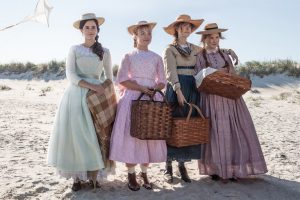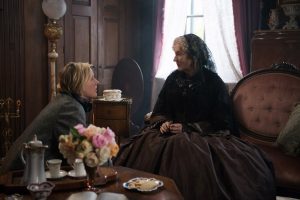A century and a half has passed since Louisa May Alcott first set pen to paper and sat down to write the semi-autobiographical story of four sisters’ journeys towards adulthood, but the tale of the “little women” is still just as relevant and iconic nowadays as it was back in 1868. And visionary director Greta Gerwig has lovingly (and masterfully) crafted an adaptation of Alcott’s classic that is not only faithful to the original book, but more in line with both modern sensibilities and Alcott’s own feminist philosophy than any previous iteration.
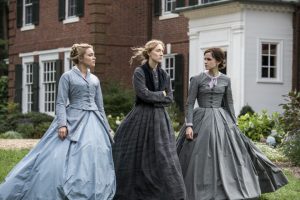
Gerwig has, first and foremost, chosen to tell the story in a non-linear fashion: while this decision may confuse the unwary (which is why I’m warning you in advance), it is a conscious choice that enables Gerwig to have what are essentially two stories simultaneously playing out onscreen, linked through flashbacks, flash-forwards, and what some may view as a bit of fourth-wall breaking – one story being the first half of the novel Little Women, covering the March sisters’ adolescence and happy, hazy childhood, awash in golden lighting; the other being the novel’s latter half, the grimmer, bleaker post-Civil War era, in which the March sisters have all grown up and gone their separate ways, and heroine Jo March (Saoirse Ronan) is beginning to more closely resemble Alcott herself. But while this might at first appear to be a narrative trick to keep the story compelling, it becomes clear in the film’s final minutes that there’s a shockingly exciting reason for the non-linear structure, one that will make Gerwig’s Little Women a topic for debate for many years to come. Keep your eyes peeled, for Gerwig drops plenty of clues and hints as to what’s coming in the finale, but you still might be caught off-guard if you’re not looking – or you might even miss it altogether.
Little Women is beloved because of its cast of extremely relatable and interesting characters, many of whom are best known to movie-lovers through the 1994 adaptation of the novel that starred Winona Ryder as the rebellious, free-spirited heroine, and a young Christian Bale as her love interest, charming, carefree Laurie. But Gerwig’s Jo and Laurie are slightly more modernized than the prim and proper couple of that film: Laurie, here excellently portrayed by rising star Timothée Chalamet, is a gentle, easygoing, and somewhat gender-neutral character who feels like the perfect soulmate to Saoirse Ronan’s socially awkward but passionate Jo – neither is entirely comfortable within the constraints laid upon them by their gender, but neither can do anything but fight the system in small ways – whether that means marrying for love or trying to establish their own place in the world. To reinforce the essentially gender-fluid relationship between the stars, Gerwig even had Ronan and Chalamet swap articles of clothing onset in order to break down the boundaries between them.
Personally, I’ve always been a huge fan of Jo March: it’s sort of a mandatory thing, I think, for most writers. We love her not just because of how sympathetic her daily struggles are, but because of how she chooses to use the written word as a weapon in her fight – hers is a pen far mightier than any sword.
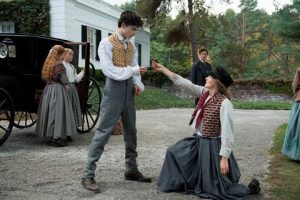
But Gerwig also allows the other March siblings to have their chance to shine: romantic, idealistic Meg (Emma Watson) is finally given a leg to stand on in her ongoing struggle with her character’s critics and detractors, who have always claimed she’s the least feminist of the sisters, and the most outdated in this modern age. Petty, vainglorious Amy (Florence Pugh) is actually respectable in Gerwig’s film – yes, she’s still a brat, but she’s also forced to grow up too quickly and bear a heavy burden upon her shoulders; she’s the only one of the March sisters who has a chance of marrying well, and for women in Alcott’s era, marriage was a woman’s only respectable method of achieving success. Amy’s speech to Laurie in which she details all the ways in which marriage is nothing but “an economic proposition” is one of the film’s most powerful scenes. Then there’s poor Beth (Eliza Scanlen), who is crucial to the story’s plot but still never quite rises above being the shy, pious outlier in the group without very much to say or do.
On the sidelines, Laura Dern and Meryl Streep have small but excellent performances as Marmee and Aunt March, respectively. Streep, especially, is a delightful addition to the cast with her biting wit, passive aggressive humor, and dainty mannerisms. Louis Garrel has the thankless job of portraying Professor Friedrich Bhaer, one of the most purposefully disappointing characters in Alcott’s novel, but he plays the role as well as he possibly can.
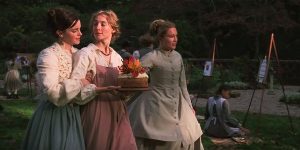
Little Women is also an exceptionally beautiful film, with a myriad of dreamy, pastel-colored scenes that look almost like they leaped straight from the painter’s canvas onto the big screen (a special shout-out goes to cinematographer Yorick Le Saux, who apparently had the camera follow the Marches like a “fifth sister”, dancing and twirling with them on their youthful frolics and adventures, giving the audience a chance to feel even more connected to the close-knit cast). The production and costume design are superb: every detail of the March family’s dark, cozy homestead and every accouterment of high-society Parisian fashion is lovingly crafted.
Greta Gerwig deserves the Oscar for Best Director, and the fact that just this morning it was revealed that she is one of a multitude of talented women not on the Academy Awards shortlist for that honor is a travesty. What she has designed, directed and delivered is a love-letter to both Alcott’s novel and to Alcott herself, who was forced to play a part all her life and sacrifice her artistic freedom. A century and a half later, Gerwig has finally done justice to this author’s work in a way that seemed almost unimaginable to me, going into the theater. Little Women is an instant classic, despite how hard Hollywood will try to ignore or downplay this incredible work of art.
Movie Rating: 9/10

